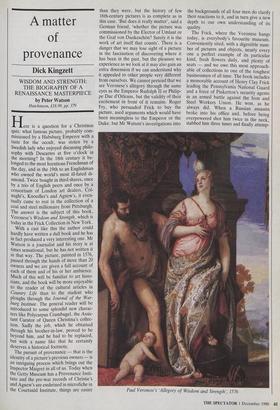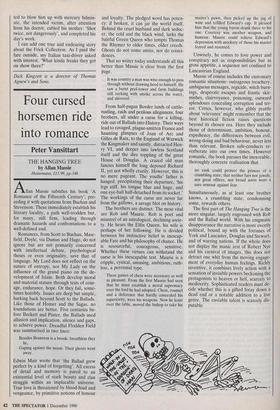A matter of provenance
Dick Kingzett
WISDOM AND STRENGTH: THE BIOGRAPHY OF A RENAISSANCE MASTERPIECE by Peter Watson
Hutchinson, £18.99, pp. 379
Here is a question for a Christmas quiz: what famous picture, probably com- missioned by a Habsburg Emperor with a taste for the occult, was stolen by a Swedish lady who enjoyed discussing philo- sophy with Descartes at five o'clock in the morning? In the 18th century it be- longed to the most licentious Frenchman Of the day, and in the 19th to an Englishman who owned the world's most ill-fated di- amond. Twice bought in third shares, once by a trio of English peers and once by a consortium of London art dealers, Col- naghi's, Knoedler's and Agnew's, it even- tually came to rest in the collection of a coal and steel millionaire from Pittsburgh. The answer is the subject of this book, Veronese's Wisdom and Strength, which is today in the Frick Collection in New York. With a cast like this the author could hardly have written a dull book and he has in fact produced a very interesting one. Mr Watson is a journalist and his story is at times sensational, but he has not written it in that way. The picture, painted in 1576, passed through the hands of more than 20 owners and we are given a full account of each of them and of his or her ambience. Much of this will be familiar to art histo- rians, and the book will be more enjoyable to the reader of the cultural articles in Country Life than to the student who ploughs through the Journal of the War- burg Institute. The general reader will be introduced to some splendid new charac- ters like Polycarpus Crumbugel, the Assis- tant Curator of Queen Christina's collec- tion. Sadly the job, which he obtained through his brother-in-law, proved to be beyond him, and he had to be replaced, but with a name like that he certainly deserves a historical footnote.
The pursuit of provenance — that is the identity of a picture's previous owners — is an intriguing process which brings out the Inspector Maigret in all of us. Today when the Getty Museum has a Provenance Insti- tute and the pre-war records of Christie's and Agnew's are enshrined in microfiche in the Courtauld Institute, things are easier than they were, but the history of few 16th-century pictures is as complete as in this case. Tut does it really matter', said a German friend, 'whether the picture was commissioned by the Elector of Umlaut or the Graf von Dankeschon? Surely it is the work of art itself that counts'. There is a danger that we may lose sight of a picture in the fascination of discovering where it has been in the past, but the pleasure we experience as we look at it may also gain an extra dimension if we can understand why it appealed to other people very different from ourselves. We cannot pretend that we see Veronese's allegory through the same eyes as the Emperor Rudolph H or Philip- pe Duc d'Orleans, but the validity of their excitement in front of it remains. Roger Fry, who persuaded Frick to buy the picture, used arguments which would have been meaningless to the Emperor or the Duke, but Mr Watson's investigations into the backgrounds of all four men do clarify their reactions to it, and in turn give a new depth to our own understanding of its quality.
The Frick, where the Veronese hangs today, is everybody's favourite museum. Conveniently sited, with a digestible num- ber of pictures and objects, nearly every one a perfect example of its particular kind, fresh flowers daily, and plenty of seats — and we owe this most approach- able of collections to one of the toughest businessmen of all time. The book includes a memorable account of Henry Clay Frick leading the Pennsylvania National Guard and a force of Pinkerton's security agents in an armed battle against the Iron and Steel Workers Union. He won, as he always did. When a Russian assassin broke into his office and, before being overpowered shot him twice in the neck, stabbed him three times and finally attemp- Paul Veronese's 'Allegory of Wisdom and Strength', 1576 ted to blow him up with mercury fulmin- ate, the intended victim, after attention from his doctor, cabled his mother: 'Shot twice, not dangerously', and completed his day's work.
I can add one true and endearing story about the Frick Collection. As I paid the fare outside, my Italian taxi-driver asked with interest, 'What kinda freaks they got on show there?'
Dick Kingzett is a director of Thomas Agnew's and Sons.











































































 Previous page
Previous page